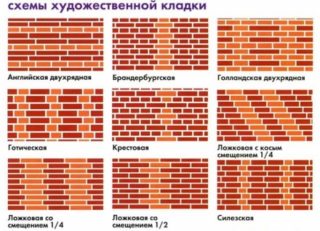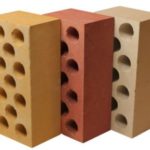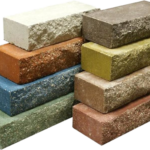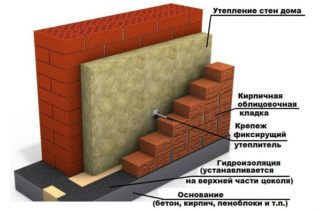The construction industry is developing at a tremendous pace and new materials appear every year, but many craftsmen prefer to use proven bricks for facade finishing. It is expensive to completely build a house out of it. Facing brick for the facade will help to solve the problem.
Cladding rules
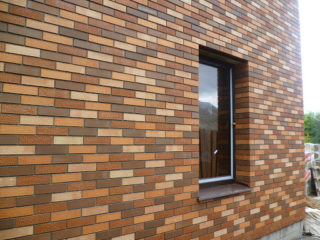
Before laying the material on the outside of the wall, you need to consider the features of the process:
- When combining several types of bricks, in order to avoid aesthetic defects, a trial row is preliminarily formed.
- The masonry is supplemented with a ventilation gap, with the help of which moisture will escape from under the cladding without destroying the base.
- Installation of bricks for facade decoration can be carried out only in the warm season.
- The elements should be cut with a grinder. In this case, a special disc is used for cutting solid building materials.
- Before laying, the finishing material is kept in water for some time so that it does not absorb moisture from the solution, deteriorating its quality.
- For cladding, the foundation must be equipped.
- You should not make the seams so that they protrude relative to the plane of the wall.
- It is possible to eliminate excess masonry mortar using a perchloric acid solution, which is used to treat the surface after construction is completed.
To prevent the cladding from collapsing or shifting over time, it is attached to the facade. For this purpose, metal rods, dowels with a diameter of 0.6 cm are used. Fasteners are installed every 4 rows laid up.
Facing brick finishes
Masonry options:
- Straight. Assumes the use of only one type of material. The position of the element can be any, the rows are allowed to alternate.
- Decorative. This type is characterized by the use of several types of finishing materials. A geometric ornament and a rosette are laid out on the base. For the correct implementation of the work, counting the rows is required, observing a certain arrangement of different colors. To increase the accuracy of the installation, a facade diagram is drawn before starting it.
- Art. This option is the most difficult. It involves the formation of volumetric patterns.
Depending on the type of placement of bricks, there are laying schemes: gothic, cross, Dutch, chain, spoon in half a brick. There are other options for mounting elements.
Varieties of facing bricks
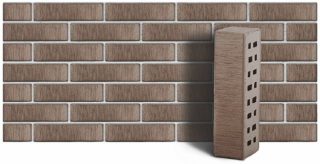
Facing the facade of a house with bricks is a responsible procedure, therefore, they carefully approach the choice of finishing material. Usually ceramic, clinker, silicate or hyper-pressed products are used.
Clinker
Clinker bricks have increased strength characteristics. For its manufacture, kaolin enriched with oxides is used. During firing, a chemical reaction takes place, which makes the product strong and dense. The dimensions of the material are standard or individual. The elements do not absorb moisture, so their structure is not disturbed for a long time.
The advantage of cladding is good decorative effect, resistance to repeated exposure to negative temperatures, and the formation of mold. After the laying of the masonry, the cladding is very easy to care for: it is periodically cleaned of dust. The downside of the material is its cost and the large weight of the finished structure. For its installation, a reinforced foundation is required. When using clinkers, the high level of their thermal conductivity is also taken into account.
Ceramic
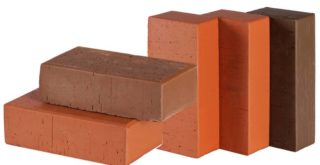
Ceramic bricks are made from clay and special additives. Formed blanks are first dried and then fired. Mineral-based dyes are used to change the color of the material. The advantage of the product is their variety. The brick can be glossy, matte or with a stone pattern.
The facing version is resistant to mechanical stress, does not fade under the influence of direct sunlight, and tolerates negative temperatures well. Since the material is capable of absorbing moisture, it must be treated with a hydrophobic impregnation.
If ceramic cladding is used to decorate an old house, additional foundation reinforcement will be required. It is difficult to carry out the installation on your own, since you need special skills.
Hyperpressed
Hyper-pressed material is considered the most durable, so it can be used not only for finishing work. For the manufacture of products, cement and shell rock waste are used. Obtaining quality material is possible due to the processing of raw materials under high pressure.
The advantage of such a brick is resistance to negative temperatures, moisture, durability. The cost of the material is low. In addition, it is possible to reduce the consumption of concrete solution during masonry, since the elements have good adhesion. The disadvantage of the material is considered to be a lot of weight.
Silicate
For the manufacture of silicone bricks, quartz sand, lime and water are used. The formed elements are fired under pressure. This option is considered the cheapest, it is distinguished by a variety of shades and UV resistance. Products have precise geometry and dimensions.
Weight, dimensions, marking
When choosing a front facing brick, its dimensions are taken into account. There is a specific standard for each type of material:
- Ceramic: 250 * 120 * 65mm.
- Ceramic thickened: 250 * 120 * 88mm.
- Clinker: 250 * 120 * 65 mm, 250 * 90 * 65 mm, 250 * 60 * 65 mm.
- Clinker long: 528 * 108 * 37 mm.
- Hyper pressed smooth: 250 * 120 * 88 mm.
- Hyper pressed smooth thickened: 250 * 120 * 88 mm.
Product marking is a designation consisting of letters and numbers. It encodes: the limit of compressive strength (100-300 kgf / cm²), bending (16-33 kgf / cm²). In addition, the thermal conductivity, frost resistance, degree of absorption, voidness and mass of the element are indicated.
Features of masonry technology
- container for solution preparation;
- grinder, measuring tape, plumb line and building level;
- trowel, square;
- seam template;
- cord and pencil for marking.
The outer part of the wall must be cleaned of debris and damaged elements. If necessary, it is leveled with plaster. When preparing the solution, it must be borne in mind that the strength of the brickwork depends on its quality.
To determine the size and location of the seams, a trial installation is carried out. In this case, do not use a solution. After the preparatory work, the direct installation of the brick begins. Laying begins from the corner of the house. In this case, the thickness of the seams must be the same, therefore, special templates are used. To make the rows even, a cord is pulled between the corner elements.Each time, the accuracy of the masonry is checked with a building level, and its verticality - with a plumb line.
5-6 rows of material are laid out at a time. To smooth the mortar in the seams, a special trowel is required. If the mixture gets on the front side of the cladding, it must be removed immediately. After completion of the work, the finished structure is covered with plastic wrap for 3-4 hours to protect the structure from possible precipitation.
Brick cladding is not a cheap option, but it is durable and beautiful. Certain skills are needed to complete the work independently, but if the technology is followed, the work will be done quickly and efficiently.

